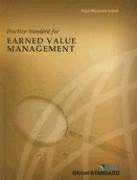
Practice Standard For Earned Value Management PDF
Preview Practice Standard For Earned Value Management
Project Management Institute Practice Standard for EARNED VALUE MANAGEMENT Global Project Management Institute Practice Standard for Earned Value Management PracticeStandardforEarnedValueManagement ISBN:1-930699-42-5 Publishedby: ProjectManagementInstitute,Inc. FourCampusBoulevard NewtownSquare,Pennsylvania19073-3299USA. Phone:610-356-4600/Internet:www.pmi.org Coverandinteriordesign: AutomatedGraphicSystems,Inc. ©2005ProjectManagementInstitute,Inc.Allrightsreserved. ‘‘PMI’’,thePMIlogo,‘‘PMP’’,thePMPlogos,‘‘PMBOK’’,‘‘ProjectManagementJournal’’,‘‘PMNetwork’’,andPMITodaylogoare registeredmarksofProjectManagementInstitute,Inc.ForacomprehensivelistofPMImarks,contactthePMILegalDepartment. PMIPublicationswelcomescorrectionsandcommentsonitsbooks.Pleasefeelfreetosendcommentsontypographical,formatting,or othererrors.Simplymakeacopyoftherelevantpageofthebook,marktheerror,andsenditto:BookEditor,PMIPublications,Four CampusBoulevard,NewtownSquare,PA19073-3299USA,ore-mail:[email protected]. PMIbooksareavailableatspecialquantitydiscountstouseaspremiumsandsalespromotions,orforuseincorporatetraining programs,aswellasothereducationalprograms.Formoreinformation,pleasewritetoBookstoreAdministrator,PMIPublications,Four CampusBoulevard,NewtownSquare,PA19073-3299USA,ore-mail:[email protected]. PrintedintheUnitedStatesofAmerica.Nopartofthisworkmaybereproducedortransmittedinanyformorbyanymeans,electronic, manual,photocopying,recording,orbyanyinformationstorageandretrievalsystem,withoutpriorwrittenpermissionofthepublisher. ThepaperusedinthisbookcomplieswiththePermanentPaperStandardissuedbytheNationalInformationStandardsOrganization (Z39.48–1984). 10 9 8 7 6 5 4 3 2 1 Contents Preface ...............................................................................................................................vii Chapter1—Introduction ........................................................................................................1 1.1 TheRoleofEarnedValueManagement ................................................................1 1.2 EVMandtheProjectManagementProcess ..........................................................2 Chapter2—BasicElementsofEarnedValueManagement......................................................7 2.1 DescriptionsoftheBasicEVMElements ..............................................................7 PlannedValue ..............................................................................................7 EarnedValue ................................................................................................8 ActualCost...................................................................................................8 2.2 DerivationsoftheBasicEVMElements................................................................9 PlannedValue ..............................................................................................9 EarnedValueMeasurementTechniques .........................................................9 EarnedValue ..............................................................................................12 ActualCost.................................................................................................13 2.3 PuttingitAllTogether........................................................................................13 Chapter3—EVMPerformanceAnalysisandForecasting .......................................................15 3.1 ScheduleAnalysisandForecasting(Howarewedoingtimewise?) .......................17 ScheduleVariance(Areweaheadorbehindschedule?) ................................17 SchedulePerformanceIndex(Howefficientlyareweusingtime?) ..................17 TimeEstimateatCompletion(Whenarewelikelytofinishwork?) ..................17 3.2 CostAnalysisandForecasting(Howarewedoingcostwise?) ..............................18 CostVariance(Areweunderoroverourbudget?) .........................................18 CostPerformanceIndex(Howefficientlyareweusingourresources?) ...........19 To-CompletePerformanceIndex(Howefficientlymustweuseourremaining resources?) .............................................................................................19 EstimateatCompletion(Whatistheprojectlikelytocost?) ..........................19 VarianceatCompletion(Willwebeunderoroverbudget?) ............................19 EstimatetoComplete(Whatwilltheremainingworkcost?) ...........................20 3.3 ManagementbyException.................................................................................20 Chapter4—GuidancefortheUseofKeyEVMPractices .......................................................23 4.1 EstablishaPerformanceMeasurementBaseline ................................................23 DecomposeWorkScopetoaManageableLevel ...........................................23 AssignUnambiguousManagementResponsibility .........................................24 DevelopTime-PhasedBudgetforEachWorkTask .........................................24 SelectEarnedValueMeasurementTechniquesforAllTasks .........................24 MaintainIntegrityofPerformanceMeasurementBaselinethroughoutthe Project ....................................................................................................24 4.2 MeasureandAnalyzePerformanceAgainsttheBaseline .....................................24 RecordResourceUsageDuringProjectExecution..........................................24 ObjectivelyMeasurethePhysicalWorkProgress ...........................................25 CreditEarnedValueAccordingtoEarnedValueTechniques ...........................25 AnalyzeandForecastCost/SchedulePerformance ........................................25 ReportPerformanceProblemsand/orTakeAction ........................................25 AppendixA—GuidelinesforaProjectManagementInstitutePracticeStandard ....................27 AppendixB—EvolutionofPMI’sPracticeStandardForEVM .................................................29 ©2005ProjectManagementInstitute,FourCampusBoulevard,NewtownSquare,PA19073-3299USA iii AppendixC—ContributorsandReviewersofthePracticeStandardforEarnedValue Management ..................................................................................................33 C.1 PracticeStandardforEarnedValueManagementProjectCoreTeam....................33 C.2 PracticeStandardforEarnedValueManagementProjectContributors .................34 C.3 PracticeStandardforEarnedValueManagementProjectTeamMembers.............34 C.4 FinalExposureDraftReviewersandContributors ................................................35 C.5 PMIProjectManagementStandardsProgramMemberAdvisoryGroup .................36 C.6 ProductionStaff................................................................................................36 AppendixD—AdditionalSourcesofInformation ....................................................................37 Publications................................................................................................37 Organizations..............................................................................................38 EducationandTraining ................................................................................38 AppendixE—ReviewsofSelectedBooksonEVM .................................................................39 EarnedValueProjectManagement,SecondEdition .......................................39 ProjectManagementUsingEarnedValue......................................................41 FundamentalsofProjectPerformanceMeasurement,FourthEdition ...............42 ProjectManagement:TheCommonSenseApproach:UsingEarnedValueto BalancetheTripleConstraint ...................................................................44 References ..........................................................................................................................47 Glossary ..............................................................................................................................49 Index by Keyword ................................................................................................................51 iv ©2005ProjectManagementInstitute,FourCampusBoulevard,NewtownSquare,PA19073-3299USA List of Figures Figure1-1: EVMandProjectManagement ...............................................................................2 Figure1-2: EVMandtheBasicPMProcess .............................................................................3 Figure1-3: ControlAccountMatrix ..........................................................................................3 Box1-1: ScalingEVMtoFitVaryingSituations ........................................................................4 Figure1-4: WorkPlan—Gantt(Bar)Chart ................................................................................5 Figure1-5: PerformanceMeasurementBaseline(PMB) ............................................................5 Figure2-1: CumulativePlannedValueforProjectEZ ................................................................8 Figure2-2: CumulativePlannedValueandEarnedValueforProjectEZ .....................................8 Figure2-3: CumulativePlannedValue,EarnedValueandActualCostforProjectEZ ..................9 Figure2-4: WorkPlanforProjectEZ......................................................................................10 Figure2-5: EarnedValueMeasurementTechniques ...............................................................10 Figure2-6: WorkPlanandStatusforProjectEZ(AsofApril30) .............................................12 Figure2-7: CumulativePlannedValue,EarnedValue,andActualCostforProjectEZ (AsofApril30) ...................................................................................................14 Figure3-1: EVMPerformanceMeasures ...............................................................................16 Figure3-2: EVMandBasicProjectManagementQuestions ....................................................16 Figure3-3: InterpretationsofBasicEVMPerformanceMeasures ............................................16 Box3-1: Time-BasedScheduleMeasures—AnEmergingEVMPractice ...................................18 Box3-2: AlternativeCalculationsofEstimateatCompletion(EAC) ..........................................21 Box3-3: PerformanceReporting ...........................................................................................22 ©2005ProjectManagementInstitute,FourCampusBoulevard,NewtownSquare,PA19073-3299USA v Preface ThePracticeStandardforEarnedValueManagement(EVM)hasbeendevelopedasa supplementtoAGuidetotheProjectManagementBodyofKnowledge(PMBOK(cid:1)Guide). The Practice Standard for EVM is designed to provide readers who are familiar with thePMBOK(cid:1)GuidewithafundamentalunderstandingoftheprinciplesofEVMand itsroleinfacilitatingeffectiveprojectmanagement. ThePracticeStandardforEVMassumesthatthereaderhasabasicworkingknowl- edgeofProjectManagementProcessGroups,KnowledgeAreas,andotherkeyconcepts suchasworkbreakdownstructures(WBS)andcriticalpathmethod(CPM)scheduling, asoutlinedinthePMBOK(cid:1)Guide.Ifthatisnotthecase,itisrecommendedthatthe readerundertakeareviewofthePMBOK(cid:1)GuidebeforereadingthePracticeStandard forEVM. ThePracticeStandardforEVMisorganizedasfollows: Introduction.AbriefoverviewofEVM,highlightingthekeymanagementquestions EVM can help answer and exploring where EVM fits into the project manage- mentuniverse. Basic Elements of Earned Value Management. This section discusses the three cornerstones of EVM: Planned Value (PV), Earned Value (EV), and Actual Cost (AC).Itexamineshowthesethreedatapointsaredeterminedandhowtheyrelate tooneanother. EVMPerformanceAnalysisandForecasting.Thissectiondescribesvariances,indi- ces,andforecaststhatcanbedevelopedusingPlannedValue(PV),EarnedValue (EV),andActualCost(AC).Thechapteralsoexamineshowthesevariances,indices, andforecastscanbeusedtoansweressentialmanagementquestions. GuidancefortheUseofKeyEVMPractices.ThissectionoutlinesbasicEVMprac- ticesintheirprojectmanagementcontextandshowshowEVMpracticesfacilitate project planning and control for better management of project cost and schedule performance. Glossary. This section provides concise definitions of key terms used throughout thisPracticeStandard.MostofthesetermsalsoappearinthePMBOK(cid:1)Guide—Third Edition’sglossary.Note,however,thatmanyofthePMBOK(cid:1)Guide’sdefinitionsare broader and more inclusive, since they apply beyond the scope of the Practice StandardforEarnedValueManagement. Appendices.TheseofferadditionalsourcesofEVMconceptsandmethodsforfurther studyandinformationrelatedtothedevelopmentofthePracticeStandard. ©2005ProjectManagementInstitute,FourCampusBoulevard,NewtownSquare,PA19073-3299USA vii Chapter 1 Introduction 1.1 THE ROLE OF EARNED VALUE MANAGEMENT Feedback is critical to the success of any project. Timely and targeted feedback can enable project managers to identify problems early and make adjustments that can keepaprojectontimeandonbudget. EarnedValueManagement(EVM)hasprovenitselftobeoneofthemosteffective performancemeasurementandfeedbacktoolsformanagingprojects.Itenablesman- agerstoclosetheloopintheplan-do-check-actmanagementcycle. EVMhasbeencalled‘‘managementwiththelightson’’becauseitcanhelpclearly and objectively illuminate where a project is and where it is going—as compared to where it was supposed to be and where it was supposed to be going. EVM uses the fundamentalprinciplethatpatternsandtrendsinthepastcanbegoodpredictorsof thefuture. EVMprovidesorganizationswiththemethodologyneededtointegratethemanage- ment of project scope,schedule, and cost. EVM can play a crucialrole in answering managementquestionsthatarecriticaltothesuccessofeveryproject,suchas: ● Areweaheadoforbehindschedule? ● Howefficientlyareweusingourtime? ● Whenistheprojectlikelytobecompleted? ● Arewecurrentlyunderoroverourbudget? ● Howefficientlyareweusingourresources? ● Whatistheremainingworklikelytocost? ● Whatistheentireprojectlikelytocost? ● Howmuchwillwebeunderoroverbudgetattheend? If the application of EVM to a project reveals that the project is behind schedule oroverbudget,theprojectmanagercanusetheEVMmethodologytohelpidentify: ● Whereproblemsareoccurring ● Whethertheproblemsarecriticalornot ● Whatitwilltaketogettheprojectbackontrack. ©2005ProjectManagementInstitute,FourCampusBoulevard,NewtownSquare,PA19073-3299USA 1 Chapter1—Introduction 1.2 EVM AND THE PROJECT MANAGEMENT PROCESS The effective use of EVM requires that it is used on projects where the principles of goodprojectmanagement,asoutlinedinAGuidetotheProjectManagementBodyof Knowledge (PMBOK(cid:1) Guide), are being applied. To establish a basic foundation for understanding EVM’s role in effective project management, it is important that we examinetherelationshipbetweenEVMandthePMBOK(cid:1)Guide’sProjectManagement ProcessGroupsandKnowledgeAreas. Project management is primarily a matter of planning, executing, and controlling work.Figure1-1indicatestheareasofprojectmanagementtowhichEVMisfundamen- tallymostapplicable. Figure1-1. EVMandProjectManagement Projectplanningismostlyamatterofdetermining: ● Whatworkmustbedone(scope)andinwhatpieces(workbreakdownstructure) ● Whoisgoingtoperformandmanagethework(responsibilityassignmentmatrix) ● Whentheworkisgoingtobedone(schedule) ● Howmuchlabor,materials,andrelatedresourcestheworkisgoingtorequire(cost). Project execution is primarily a matter of doing the planned work and keeping workersandmanagersinformed. Projectcontrolfocusesmostlyonmonitoringandreportingtheexecutionofproject management plansrelated to scope, schedule,and cost, along withquality and risk. Inotherwords,projectcontrolisaprocessforkeepingworkperformanceandresults withinatolerablerangeoftheworkplan. Asaperformancemanagementmethodology,EVMaddssomecriticalpracticesto theprojectmanagementprocess.Thesepracticesoccurprimarilyintheareasofproject planningandcontrol,andarerelatedtothegoalofmeasuring,analyzing,forecasting, andreportingcostandscheduleperformancedataforevaluationandactionbywork- ers,managers,andotherkeystakeholders.SeeFigure1-2. 2 ©2005ProjectManagementInstitute,FourCampusBoulevard,NewtownSquare,PA19073-3299USA Chapter1—Introduction Figure1-2. EVMandtheBasicPMProcess During theproject planning process, EVMrequires the establishment ofa perfor- mancemeasurement baseline(PMB). Thisrequirement amplifiesthe importanceof projectplanningprinciples,especiallythoserelatedtoscope,schedule,andcost.EVM elevates the need for project work to be executable and manageable, and for the workersandmanagerstobeheldresponsibleandaccountablefortheproject’sperfor- mance. Project work needs to be brokendown—using a work breakdown structure—into executable tasks and manageable elements often called control accounts. Either an individual or a team needs to manage each of the work elements. All of the work needstobeassignedtotheworkforceforexecutionusinganorganizationbreakdown structure(OBS).SeeFigure1-3andBox1-1. Figure1-3. ControlAccountMatrix Project work needs to be logically scheduled and resourced in a work plan; the workscope,schedule,andcostneedtobeintegratedandrecordedinatime-phased budgetknown asa performancemeasurementbaseline (PMB).Figure1-4 illustrates ahypotheticalworkplanwithaGantt(bar)chart,towhichearnedvaluemeasurement ©2005ProjectManagementInstitute,FourCampusBoulevard,NewtownSquare,PA19073-3299USA 3
